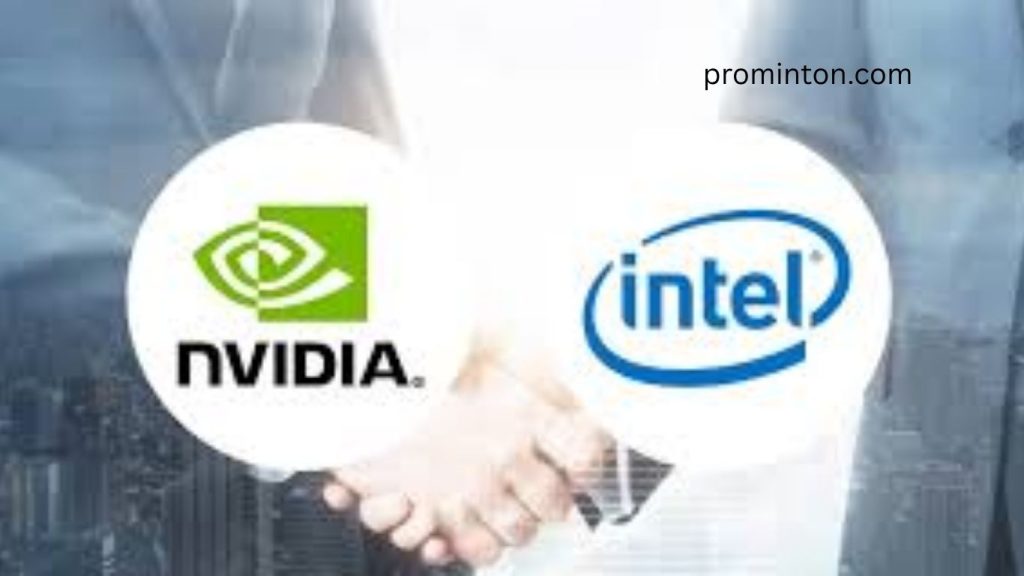In a surprising twist for the semiconductor world, Nvidia Corp. announced a $5 billion investment in Intel Corp., alongside plans for a strategic partnership to co-develop chips for PCs and data centers. This bold move sent Intel’s shares soaring and reshaped the narrative around two companies long seen as rivals in the race for chip dominance.
The deal is not only one of the biggest financial lifelines for Intel in years but also a sign of how strategic alliances are becoming critical in a fiercely competitive global semiconductor market. By combining Intel’s decades of expertise in processors with Nvidia’s unrivaled leadership in graphics and AI, both companies are positioning themselves to capture massive growth opportunities in personal computing, cloud services, and artificial intelligence.
Why This Deal Matters
The investment comes at a time when Intel has been struggling to regain its footing. Once the undisputed king of microprocessors, Intel has faced mounting pressure from rivals like AMD, Nvidia, and ARM-based chipmakers. Delays in manufacturing innovation and the global chip shortage further dented its market dominance.
For Nvidia, the move represents strategic diversification and influence. Best known for its graphics processing units (GPUs), Nvidia has already revolutionized AI and high-performance computing. By partnering with Intel, it gains access to Intel’s x86 processor ecosystem and strengthens its position in PCs and data centers—two markets crucial for future growth.
This collaboration signals that competition and cooperation can coexist in the semiconductor industry. Instead of crushing Intel, Nvidia sees value in lifting it up, ensuring both companies remain strong players against external threats, especially from Asia-based chip manufacturers.
Deal Structure and Financial Impact
According to the announcement, Nvidia will purchase Intel’s common stock at $23.28 per share, totaling $5 billion. The cash infusion gives Intel breathing room to accelerate product development and stabilize its operations.
In return, Intel will integrate Nvidia’s graphics technology into its upcoming personal computer chips, potentially improving the competitiveness of Intel-based laptops and desktops. On the data center side, Intel processors will be incorporated into products built around Nvidia hardware, a move that could create hybrid solutions appealing to cloud giants and enterprise customers.
The stock market reaction was immediate: Intel’s shares spiked on news of the deal, while Nvidia’s stock also saw gains, reflecting investor optimism about long-term synergies.
The Bigger Picture: Global Semiconductor Rivalry
The semiconductor industry is at the heart of today’s geopolitical and economic battles. Chips power everything from smartphones and laptops to artificial intelligence, military equipment, and electric vehicles. With demand exploding and supply chains stretched thin, companies are racing to secure advantages.
Intel has been lobbying the U.S. government for support under the CHIPS and Science Act, which aims to boost domestic chip manufacturing. Nvidia’s investment reinforces those efforts, strengthening a U.S.-based semiconductor ecosystem that can compete with TSMC in Taiwan and Samsung in South Korea.
By working together, Nvidia and Intel are sending a message: the future of computing will be built through collaboration, not just rivalry.
Strategic Benefits for Intel
For Intel, the partnership could not come at a better time. The company has faced:
- Repeated delays in advanced manufacturing nodes.
- Erosion of market share in PCs and servers.
- Pressure from Wall Street to deliver a turnaround plan.
The Nvidia deal provides:
- Fresh capital to fund innovation.
- Cutting-edge graphics technology to make Intel PCs more attractive.
- Data center synergies that could restore its reputation as a leader in enterprise computing.
- In short, Intel now has a powerful ally helping it regain relevance in an industry it once dominated.
What Nvidia Gains
While Nvidia is thriving, it faces its own challenges:
- Growing scrutiny from regulators over its dominance in GPUs.
- Supply chain risks tied to overseas chip fabrication.
- Rising competition from AMD and custom AI chips built by cloud providers like Google and Amazon.
By investing in Intel, Nvidia gains:
- Access to Intel’s processor ecosystem, strengthening its PC and server presence.
- A hedge against future competition, ensuring Intel remains aligned with Nvidia instead of forming alliances with rivals.
- Broader market influence, especially in AI-driven data centers where hybrid CPU-GPU systems are in high demand.
This isn’t just an investment—it’s a strategic power play.
Industry Expert Reactions
Analysts were quick to weigh in on the deal:
- Tech investors praised the move, noting that cooperation between two giants could stabilize the market and foster innovation.
- Skeptics questioned long-term alignment, pointing out that Intel and Nvidia will still compete in certain areas, including data center chips.
- Policy experts welcomed the news, highlighting how the partnership strengthens U.S. semiconductor resilience against global uncertainties.
The consensus is clear: while unusual, the Nvidia-Intel partnership could mark a turning point for the tech industry.
Potential Risks and Challenges
Every bold alliance comes with risks. Key challenges include:
- Cultural differences: Intel’s legacy as a traditional chipmaker contrasts with Nvidia’s agile, innovation-driven culture.
- Competitive tensions: Both companies still compete in high-performance computing and data center markets.
- Execution risks: Merging technologies and roadmaps will require flawless execution to deliver on promises.
If these hurdles are not managed well, the partnership could face setbacks.
Future of PCs and Data Centers
The implications for technology are enormous:
- Personal Computing: Intel PCs powered by Nvidia graphics could finally compete more directly with AMD-powered systems, offering better performance for gaming, content creation, and AI-driven applications.
- Data Centers: Hybrid systems using Intel CPUs with Nvidia GPUs could become the standard for AI workloads, cloud computing, and advanced simulations.
- AI Integration: The partnership could accelerate breakthroughs in generative AI, machine learning, and autonomous systems.
This isn’t just about business—it’s about shaping the next era of computing.
What It Means for Consumers and Businesses
For consumers, the collaboration could mean faster, more efficient laptops and desktops with superior graphics and AI capabilities. Gamers and creative professionals stand to benefit the most.
For businesses, the deal promises enhanced data center performance and energy-efficient AI solutions, crucial for cloud providers, research institutions, and enterprise users.
Ultimately, the Nvidia-Intel alliance aims to create products that deliver more power, speed, and innovation at a time when demand for smarter computing is surging.
Frequently Asked Questions:
Why did Nvidia invest $5 billion in Intel?
Nvidia invested to strengthen collaboration with Intel on chip development for PCs and data centers, while also securing strategic influence in the semiconductor market.
How will this partnership impact Intel’s future?
The deal provides Intel with capital, advanced Nvidia graphics technology, and a stronger position in data centers—helping it regain competitiveness.
What benefits does Nvidia gain from investing in Intel?
Nvidia gains access to Intel’s processor ecosystem, broader influence in PC and server markets, and a strategic hedge against rivals like AMD.
What does this mean for the global chip industry?
The alliance highlights growing collaboration among U.S. chipmakers to strengthen domestic semiconductor leadership against Asian giants like TSMC and Samsung.
How did the stock market react to the news?
Intel shares surged after the announcement, reflecting investor optimism about the partnership’s potential. Nvidia also saw positive market sentiment.
Will consumers see better products because of this deal?
Yes. The partnership is expected to deliver faster, more efficient PCs with powerful graphics, as well as advanced AI-driven data center solutions.
Are there risks to the Nvidia-Intel alliance?
Yes. Cultural differences, execution challenges, and continued competition in certain markets could pose risks to long-term success.
Conclusion
The $5 billion Nvidia-Intel alliance marks a pivotal moment in the semiconductor industry. What began as a surprising investment has quickly evolved into a powerful collaboration that could reshape the future of PCs, data centers, and AI computing. For Intel, the deal is a lifeline that brings fresh capital, renewed competitiveness, and the chance to reclaim its legacy. For Nvidia, it is a masterstroke that expands its influence and solidifies its leadership in next-generation technologies.



